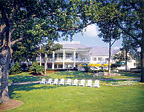
Considered one of Illinois's best golf courses, the St. Charles Country Club is located 45 miles west of Chicago in St. Charles, IL. Established in 1924, the club currently has 265 members and employs from 50 to 125 people, depending on the season. In 1987, the club added a 34,000-sq-ft clubhouse to accompany the 18-hole golf course.
By 2002, the facility's boiler system was in dire straits. At the time, the club was using two 455,000 Btuh high-efficiency heaters with a 1,500-gal storage tank to supply hot water to the club's 41 fixtures. The primary boiler had been replaced but with the storage tank leaking, the entire system needed an overhaul. Cook, whose job it is to keep the club running smoothly, considered three options for replacing the aging system: replace the boiler system with an identical one; install a system of multiple smaller tanks; or install a Takagi tankless water heater system.
When the clubhouse was built in 1987, the boiler system was installed first, and the 10-ft-by-10-ft room that housed it was erected around the system. To install identical equipment would require demolishing part of the concrete slab wall, since as a replacement tank would be too large to fit through the doorway. "I remember them saying something about a crane," Cook recalled.
Cook considered a system of several smaller tanks, which would allow the structure to stay intact during installation, but would still require dual boilers. He also wanted to cut overhead costs and was bothered that this solution would increase their utility costs. Furthermore, he found it wasteful to heat such large amounts of water during slower months and during the month of February while the club was closed.
‘There's Gotta Be A Better Way'
Jeff Swanson, owner of Abrahamson's Inc., suggested the club install a Takagi tankless water heater system. Abrahamson's had been installing Takagi units in residential homes with great success and Swanson knew this technology would benefit the club. "It is always less expensive to use residential concepts in commercial situations. You can do more with less," he explained.The Takagi units would be wall-mounted and sit dormant during the times the club had very little demand for hot water, which would drastically reduce the utility bills. And because of Takagi's unique technology, Swanson could tailor the system to meet the clubhouse's specific needs.
The following February, Abrahamson's Inc. replaced the existing boiler system. Removal of the outdated storage tank was the most difficult task that Swanson and his team faced during the job. It also ended up being the most time-consuming and largest expense of the $30,000 two-week project. To avoid structural damage, Swanson and his team disassembled the tank into small pieces with plasma cutters and carried them through the door.
After calculating the flow rate demand, Swanson designed and installed a system consisting of six Mobius T-M1s, Takagi's high-volume commercial water heater. Swanson linked the six units together using the Takagi TM-RE20 control unit. This resulted in a total output of 57.6 gpm - more than sufficient for the clubhouse's needs.
$13,500 Savings In Installation Costs
When a hot water fixture is turned on, the TM-RE20 controller senses the flow and activates one of the units. The unit then runs at the lowest Btu necessary to provide hot water. As additional fixtures are turned on, the unit accelerates the flow rate until it is at full capacity. Once a T-M1 is at full capacity, the controller switches on and activates other units until the demand is met. "With this system, we aren't ever asking the units to exceed the capacity," Swanson explained. The controller is also designed to alternate primary units, eliminating the problem of minimal lifespan of lead and lag units.Besides the ongoing energy savings, the St. Charles Country Club calculates that it saved $13,500 in installation costs by choosing the tankless system over a conventional boiler/storage system.
Several months after the system was implemented, it was put to test when the club hosted the first of their annual tournaments. As the tournament ended and the golfers hit the showers, the Takagi units kicked on one by one and provided ample hot water without disruption to the guests. ES
